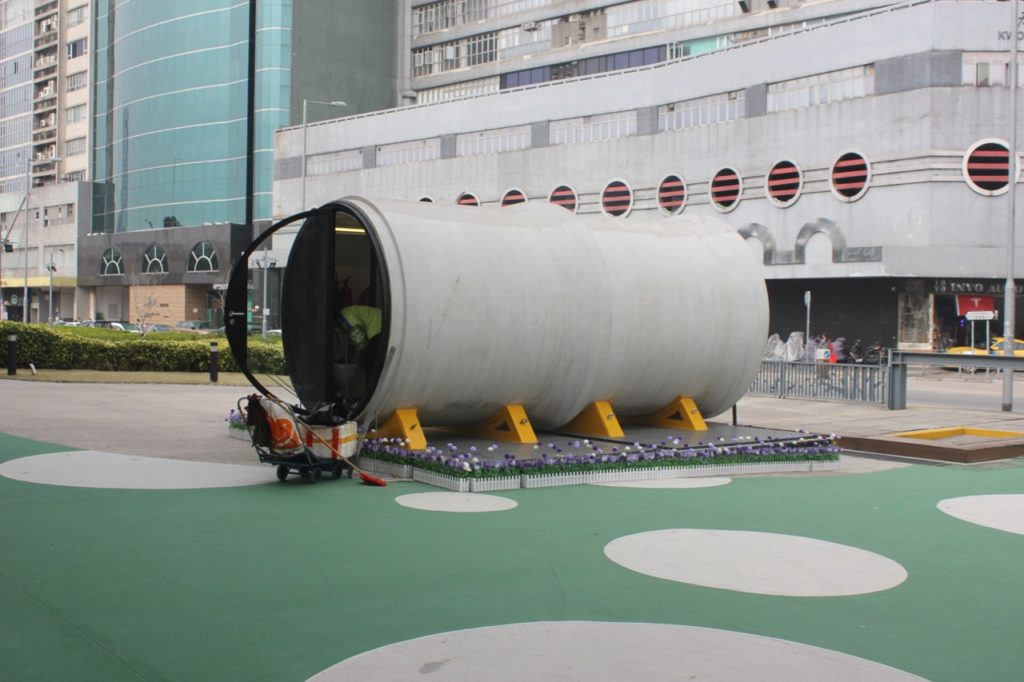“It’s so small,” said Michael, a young father, strolling with his wife and son on the Kwun Tong Promenade earlier this week.
“Maybe it would be OK for one person. But this is Hong Kong style, and I like the design.”
The design of which Michael spoke (before scurrying off without giving his surname) is the OPod, a concrete storm drain pipe fashioned into a micro-house, touted by its designer as a possible solution to Hong Kong’s housing crisis.
The design prototype, boasting (a very modest) 100 square feet of living space, is now on display at Fly the Flyover01 — where it will remain until April — so Coconuts Hong Kong decided to take a look.

When we arrived, the 2.5-meter round, 10-meter long module was being cleaned, a rather quick affair, given its interior consists of a couch that turns into a bed, several shelves, a place to hang clothes, a shower, a toilet and a few other amenities.
Soon after, curious pedestrian Helen Cheng, 29, came in for a look.
“Maybe if someone did not like cooking it would be OK,” she said, inspecting the, ah, kitchen area, with its small electric oven, sink and mini-fridge.
“Also if someone had a lot of things to store, it might be hard. It would be good for a traveler to stay in here. A long stay, I’m don’t know, but if this was a hotel, I think it is good. The design is quite fresh.”

Next up was a relatively tall gentleman (Coconuts is tiny, well suited for micro-houses) dressed in black, who appeared very comfortable in the cozy space, probably because he designed it.
“It was an idea that happened by chance,” said James Law, founder and CEO of James Law Cybertecture and the man behind the OPod who, disclaimer, Coconuts had previously arranged to meet at the site.
“I was in a construction site and I saw some of these water pipes being placed and stored in this construction yard. I went to explore them, and when I walked inside one of these things, I thought ‘oh wow, it’s not too bad’.”
Law unveiled his prototype last year, showcasing it at the Hong Kong Convention and Exhibition Centre for Business Design Week in December. The idea, he says, was a case of “putting two and two together.”
“Existing unused new water pipes equals low cost micro housing that can be built quickly and cheaply and can be placed anywhere,” he said, adding that reactions had been positive.
“We’ve been hearing from the general public that they surprisingly feel that it’s something they can really imagine living in.
“It’s not as claustrophobic or as forbidding as the title of the project, being a tube house made out of a concrete pipe, gives the impression of.”

The OPod, a non-profit project, is the second mobile micro house the firm has designed with a mind to Hong Kong’s housing crisis, following on from the AlPod, an aluminum container-side house it unveiled in 2015.
Both are designed to be stacked to form larger structures. With 450 square feet of living and working space, the AlPod is obviously much roomier than its concrete storm drain little brother but, as you might guess, also more expensive to construct.
With the concrete pipes widely available from contractors in Hong Kong, Law says the OPod, which took about a month to create and includes a special lock to allow access via a smartphone, can be fitted out for about US$15,000 (HK$117,300).

It’s pretty much “what you see is what you get,” but as Hongkongers watch property prices soar (developers have sold 152-square-feet flats for HK$3 million) that might not be so bad, particularly for the more than 250,000 on the waiting list for public rental properties.
Law says he sees OPod houses as a stop-gap measure. A place for young people to live for one or two years and save some money while avoiding ending up in shabby sub-divided flats or cage homes, often tiny, poorly ventilated and badly managed.
“This is trying to raise the level of quality of space and decency for lower income classes,” he said.
Law, who grew up in Hong Kong, went to high school in the UK and studied at the Bartlett School of Architecture at University College London, has incorporated “alleviating human suffering” into his Cybertecture philosophy of technology-led design.
His firm is behind projects in several countries including The Pad, a building inspired by an Apple iPod, in Dubai; and The Capital, a building that looks a bit like a glass speaker, in Mumbai.
Following the OPod’s unveiling, Law said he project has drawn interest from “NGOs and institutions” working to address Hong Kong’s housing shortage and groups from abroad but he said it was still “very early days” on any plans to move beyond a prototype.

Ideally, Law sees the OPod as being used to transform the spare nooks and crannies available within cities into housing, like the space under flyovers and between or on top of buildings.
However, such a solution, he concedes, still appears well outside the framework of Hong Kong’s building regulations. Nonetheless, it’s an interesting idea to have in the pipeline.
“I think there is hurdle to get over in terms of how to address the introduction of this type of architecture in Hong Kong,” he said.
“However… the OPod specifically opens up a discussion for Hong Kong to consider a new realm of architecture.”





Reader Interactions